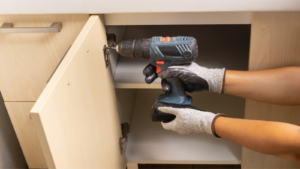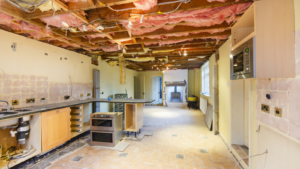
In the realm of home renovation, cabinet refurbishing has emerged as a popular, cost-effective solution for homeowners seeking a fresh look without breaking the bank.
Stay tuned to explore the benefits, techniques, and potential savings associated with this unique renovation approach.
Cabinet Refurbishing
The Basics of Cabinet Refurbishing
Cabinet refurbishing, in essence, rescues old, worn-out cabinetry. The process involves rigorous cleaning, fixing defects, sanding surfaces, and then applying fresh paint or stain. Sometimes, refurbishing includes hardware maintenance such as replacing nobs, hinges, and pulls.
Truly, cabinet refurbishing surpasses mere aesthetics. It also prmotes reuse, thereby furthering sustainability by reducing waste.
Planning Your Cabinet Refurbishment Project
In light of cabinet refurbishing’s popularity and value, planning becomes a critical first step in this transformation. It involves accounting for financial considerations, style preferences, and project objectives, among other aspects.
Choosing a Style for Your Refurbished Cabinets
Style selection forms another essential component of the planning phase, primarily reflecting personal taste. It also functions as a gauge to measure the changes desired. Refurbishing often involves revamping the existing style or utter transformation into a new look.
When it comes to style choices, options abound. Traditional styles typically focus on details and classic finishes, whereas modern styles emphasize minimalism and sleek functionality.
The Cabinet Refurbishing Process

Harnessing homeowners’ desire to refresh their spaces without breaking the bank, cabinet refurbishing presents a budget-friendly alternative to total overhaul. Derived from the preceding content, this part of the article delves deeper into the nuts and bolts of the cabinet refurbishing process.
Step-by-Step Guide to Cabinet Refurbishing
Cabinet refurbishing entails a systematic approach. First, evaluate your cabinets’ condition to determine the areas needing attention. Examples include faded paint, damaged hardware, or age-induced wear. Second, prepare by cleaning the cabinets diligently.
Safety Tips During Cabinet Refurbishing
Protecting oneself during the refurbishing process requires prescience. One, always engage in adequate ventilation. Working in a well-ventilated area prevents inhalation of fumes from paint or other chemicals. Two, use safety gear.
The Benefits of Cabinet Refurbishing
Refurbishing cabinets presents numerous advantages. These range from environmental impacts to adding tangible value to homes. This section delves into these benefits, providing comprehensive insights into why cabinet refurbishing stands as a popular choice among homeowners.
Environmental Impact of Cabinet Refurbishing
Cabinet refurbishing significantly reduces their environmental footprint. Compared to purchasing newly manufactured cabinets, refurbishment uses fewer raw materials. New production involves logging trees for timber and energy consumption during manufacturing, contributing to carbon emissions and deforestation.
Value Addition for Your Home
Besides ecological win, cabinet refurbishing can contribute to increased property value. Updating an outdated kitchen with refurbished cabinets elevates both the aesthetic appeal and functionality, positively swaying potential buyers’ perceptions and willingness to invest.
Maintenance Tips After Cabinet Refurbishing

After investing time, effort, and money into refurbishing your cabinets, maintaining their newfound splendor is paramount. With a touch of diligence, it’s not difficult to keep them looking as good as new. Here are a couple of techniques and habits to consider.
How to Keep Refurbished Cabinets Looking New
Regular dusting serves as a handy way to maintain the brand new look of refurbished cabinets. Do this at least once a week, so dust particles don’t accumulate, dulling the refurbished cabinet’s vibrant look.
Using shelf liners offers an extra layer of protection. It’s an easy solution that, aside from preserving the cabinet internals, adds a touch of bespoke design individuality.
Avoiding overloading the cabinets keeps them in optimal condition. Overloaded cabinets often result in weakened hinges and misaligned doors.
Finally, always consider the finish on your cabinets. Certain finishes require distinct maintenance practices, ensuring the longest lifespan possible.
Must Know
Cabinet refurbishing isn’t just a process; it’s a smart investment that adds value to your home and promotes sustainability. It’s all about understanding the condition of your cabinets, employing the right refurbishing techniques, and committing to regular maintenance. When done right, it breathes new life into your kitchen or bathroom, enhancing the overall aesthetics and functionality. So, whether you’re planning to sell your house or just want to revamp your living space, cabinet refurbishing is a cost-effective, eco-friendly solution.
